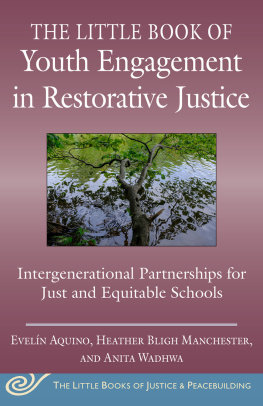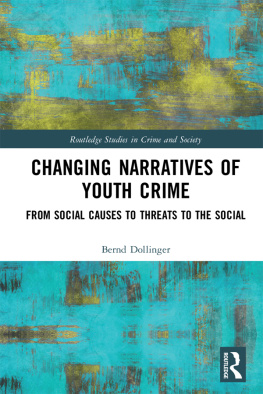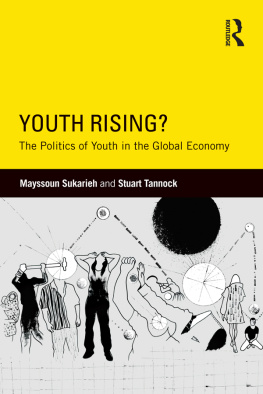Thank you for buying this ebook, published by NYU Press.
Sign up for our e-newsletters to receive information about forthcoming books, special discounts, and more!
Sign Up!
About NYU Press
A publisher of original scholarship since its founding in 1916, New York University Press Produces more than 100 new books each year, with a backlist of 3,000 titles in print. Working across the humanities and social sciences, NYU Press has award-winning lists in sociology, law, cultural and American studies, religion, American history, anthropology, politics, criminology, media and communication, literary studies, and psychology.
Dangerous or Endangered?
NEW YORK UNIVERSITY PRESS
New York and London
www.nyupress.org
2010 by New York University
All rights reserved
Library of Congress Cataloging-in-Publication Data
Tilton, Jennifer.
Dangerous or endangered? :
race and the politics of youth in urban America /
Jennifer Tilton.
p. cm.
Includes bibliographical references and index.
ISBN 978-0-8147-8311-5 (alk. paper)
ISBN 978-0-8147-8312-2 (pbk. : alk. paper)
ISBN 978-0-8147-8331-3 (e-book)
1. African American youthCaliforniaOakland.
2. Urban youthCaliforniaOakland. I. Title.
E185.93.C2T55 2010
323.1196073dc22 2010015387
New York University Press books are printed on acid-free paper, and their binding materials are chosen for strength and durability.
We strive to use environmentally responsible suppliers and materials to the greatest extent possible in publishing our books.
Manufactured in the United States of America
c 10 9 8 7 6 5 4 3 2 1
p 10 9 8 7 6 5 4 3 2 1
Acknowledgments
This book was made possible by my family and all those who have become like family to me. Together, many people have taught me what America should be and what is required from all of us if we are going to create equal opportunities for all our children. My parents, both teachers, have been wonderful models and supports. They have provided the endless day care, meals, and housing that made this research and writing possible. They also provided a foundational commitment to social justicewhether it was through my fathers stories about John Brown or my mothers efforts to challenge her parents brand of polite southern racism. My special thanks to my Chicago family, who let a young white girl cross the hard racial lines of that city into their lives and struggles to rebuild their communities. Jackie Reed and Mary Alice Ma Henry, now long gone, first taught me what activist mothering meant, and that it was never okay to write off our children. Thanks to my godsons A.C. and Nathaniel for adopting me in Chicago. They have taught me the kind of strength and perseverance required for boys to become men under conditions of American apartheid. I remain amazed by their successes in the face of the many hurdles theyve had to overcome.
I could never have written this book without the support of my wonderful husband, Jim, and my son, Zack, who learned to be patient with my long days and weekends writing. Being a mother has helped me understand the joy and imagine the fear and anger of many parents in this book, whose children have to face barriers our son will never face. Reading and writing stories of black parents whose children are stopped by the police or followed by security guards now makes me livid in a new way as I imagine how I would feel if I had to prepare my son for that reality. Similarly, as I imagine how I would feel if Zack were afraid every day walking to school past drug corners, I become more committed to fighting to create a nation where no children have to live in fear. Being a mother makes me feel on a visceral level the progressive possibility of a politics of childhood, at the same time as I see how easy it is to narrowly defend the privileges of your own child.
This book would never have been possible if countless Oakland community activists and public officials hadnt welcomed me into their meetings and homes, tolerated my questions, and trained me out of many errors. These gracious informants will recognize their own enormous contributions to this book, even though I refer to most by pseudonyms. The names of schools, organizations, neighborhoods, and public officials have not been changed. I also usually use real names when I quote from newspaper coverage, and for a few informants who requested that I use their names, including Van Jones, Jakada Imani, and Victor Duarte. I have never stopped being surprised at and thankful for the openness and patience of the community activists I have worked with and write about. Black community activists, in particular, had little reason to trust or take their valuable time to speak to a white, upper-middle-class woman from San Francisco. They had many reasons to doubt my intentions, or at least my ability to represent their concerns and political commitments accurately. I tried in my early career not to study black neighborhoods or black politics. The trope of white anthropologists studying black neighborhoods seemed tired and old, and there are so many amazing black anthropologists who have documented the complex stories of black communities. But my interests, passions, and history continued to bring me back to the racial divides in urban America and to writing, at least in part, about the dilemmas of black community activists. It is a testament to the commitment and hope of Oaklands activists that that so many people took the time to teach me and share their stories.
Many friends, colleagues, and mentors helped me through the endless process of writing and rewriting this book. Conrad Kottak, Matthew Countryman, Terry McDonald, and Janet Finn helped me through the early research and writing process. Sharon Stephens left her indelible mark on my scholarship and this book, although I only had the chance to work with her briefly. I am especially indebted to Barrie Thomas for her invaluable feedback on my ethnographic methods as I conducted research in Oakland. At various stages, Helena Hansen, Ping-Ann Addo, Kate Ledger, Linda Gajdusek, and Chris Rhomberg provided support and read and edited chapters. Many mentors and supportive critics have helped me identify the core argument and major contributions of this book, as well as find the confidence to write it; a special thanks to Cindi Katz, Brett Williams, Joe Hawes, Susan Hyatt, Setha Low, Caitlin Cahill, and Deborah Durham. Lastly, my colleagues Kim Coles and Keith Osajima, Denise Spencer, and my editor Jennifer Hammer helped me through final stages of revisions. David Martinez provided invaluable help editing and indexing the manuscript. And thanks especially to my colleagues Diana Sinton and Mark Kumler for carving time out of their busy schedules to produce the wonderful neighborhood maps for this book.
Introduction: Whos Responsible for Kids?
In June 1999, recently elected Mayor Jerry Brown visited a Neighborhood Crime Prevention Council (NCPC) meeting in an elementary school auditorium at the eastern edge of Oakland, Californias sprawling flatlands. Speaking to approximately fifty, mostly African American, middle-class homeowners, Mayor Brown detailed his plans for revitalizing the city, When I talk to people everywhere in Oakland, they are concerned about crime and schools. Crime rates were declining, but not fast enough. He knew that Oaklands citizens disagreed on how to respond; some at the meeting took an overtly hard line on crime while others focused on economic development, improving schools, or building after-school programs. When Mayor Brown opened the meeting for questions, an African American woman in her midthirties asked if the city had a plan to reduce juvenile crime. Mayor Brown mentioned new funding to open recreation centers longer, and then added, Facilities are full. Even to be arrested and held, youth have to pass a test. So it is hard to discipline youth. The woman explained that she was thinking more in terms of prevention, remarking, Locking them up doesnt work. Mayor Brown agreed: Thats our paradox. Weve got to do something, but building facilities doesnt work. So what do we do?





